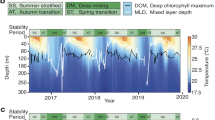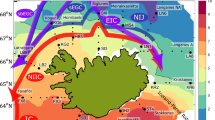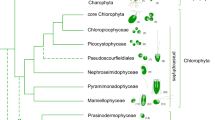Abstract
Prasinophytes clade VII is a group of pico/nano-planktonic green algae (division Chlorophyta) for which numerous ribosomal RNA (rRNA) sequences have been retrieved from the marine environment in the last 15 years. A large number of strains have also been isolated but have not yet received a formal taxonomic description. A phylogenetic analysis of available strains using both the nuclear 18S and plastidial 16S rRNA genes demonstrates that this group composes at least 10 different clades: A1–A7 and B1–B3. Analysis of sequences from the variable V9 region of the 18S rRNA gene collected during the Tara Oceans expedition and in the frame of the Ocean Sampling Day consortium reveal that clade VII is the dominant Chlorophyta group in oceanic waters, replacing Mamiellophyceae, which have this role in coastal waters. At some location, prasinophytes clade VII can even be the dominant photosynthetic eukaryote representing up to 80% of photosynthetic metabarcodes overall. B1 and A4 are the overall dominant clades and different clades seem to occupy distinct niches, for example, A6 is dominant in surface Mediterranean Sea waters, whereas A4 extend to high temperate latitudes. Our work demonstrates that prasinophytes clade VII constitute a highly diversified group, which is a key component of phytoplankton in open oceanic waters but has been neglected in the conceptualization of marine microbial diversity and carbon cycle.
Similar content being viewed by others
Log in or create a free account to read this content
Gain free access to this article, as well as selected content from this journal and more on nature.com
or
Accession codes
References
Amacher J, Neuer S, Anderson I, Massana R . (2009). Molecular approach to determine contributions of the protist community to particle flux. Deep Sea Res Part I Oceanogr Res Pap 56: 2206–2215.
Amaral-Zettler LA, McCliment EA, Ducklow HW, Huse SM . (2009). A method for studying protistan diversity doing massively parallel sequencing of V9 hypervariable regions of small-subunit ribosomal RNA Genes. PLoS One 4: e6372.
Balzano S, Marie D, Gourvil P, Vaulot D . (2012). Composition of the summer photosynthetic pico and nanoplankton communities in the Beaufort Sea assessed by T-RFLP and sequences of the 18S rRNA gene from flow cytometry sorted samples. ISME J 6: 1480–1498.
Béranger K, Mortier L, Crépon M . (2005). Seasonal variability of water transport through the Straits of Gibraltar, Sicily and Corsica, derived from a high-resolution model of the Mediterranean circulation. Prog Oceanogr 66: 341–364.
Cachon M, Caram B . (1979). A symbiotic green alga, Pedinomonas symbiotica sp. nov. (Prasinophyceae), in the radiolarian Thalassolampe margarodes. Phycologia 18: 177–184.
Collado-Fabri S, Vaulot D, Ulloa O . (2011). Structure and seasonal dynamics of the eukaryotic picophytoplankton community in a wind-driven coastal upwelling ecosystem. Limnol Oceanogr 56: 2334–2346.
Crespo C, Rodríguez H, Segade P, Iglesias R, García-Estévez JM . (2009). Coccomyxa sp. (Chlorophyta: Chlorococcales), a new pathogen in mussels (Mytilus galloprovincialis of Vigo estuary (Galicia, NW Spain). J Invertebr Pathol 102: 214–219.
Decelle J, Colin S, Foster RA . (2015a) Photosymbiosis in marine planktonic protists In Marine Protists: Diversity and Dynamics. Springer: Japan, pp 465–500.
Decelle J, Romac S, Stern R, Bendif EM, Zingone A, Guiry M et al. (2015b). PhytoREF: a reference database of the plastidial 16S rRNA gene of photosynthetic eukaryotes with curated taxonomy. Mol Ecol Resour 15: 1435–1445.
Derelle E, Ferraz C, Rombauts S, Rouze P, Worden AZ, Robbens S et al. (2006). Genome analysis of the smallest free-living eukaryote Ostreococcus tauri unveils many unique features. Proc Natl Acad Sci USA 103: 11647–11652.
de Vargas C, Audic S, Henry N, Decelle J, Mahé F, Logares R et al. (2015). Eukaryotic plankton diversity in the sunlit ocean. Science 348: 1261605.
Duanmu D, Bachy C, Sudek S, Wong C-H, Jiménez V, Rockwell NC et al. (2014). Marine algae and land plants share conserved phytochrome signaling systems. Proc Natl Acad Sci USA 111: 15827–15832.
Foulon E, Not F, Jalabert F, Cariou T, Massana R, Simon N . (2008). Ecological niche partitioning in the picoplanktonic green alga Micromonas pusilla: evidence from environmental surveys using phylogenetic probes. Environ Microbiol 10: 2433–2443.
Fuller NJ, Campbell C, Allen DJ, Pitt FD, Le Gall F, Vaulot D et al. (2006a). Analysis of photosynthetic picoeukaryote diversity at open ocean sites in the Arabian Sea using a PCR biased towards marine algal plastids. Aquat Microb Ecol 43: 79–93.
Fuller NJ, Tarran G, Cummings D, Woodward M, Orcutt DM, Yallop M et al. (2006b). Molecular analysis of photosynthetic picoeukaryote community structure along an Arabian Sea transect. Limnol Oceanogr 51: 2502–2514.
Gascard JC, Richez C . (1985). Water masses and circulation in the Western Alboran sea and in the Straits of Gibraltar. Prog Oceanogr 15: 157–216.
Giovannoni SJ, Britschgi TB, Moyer CL, Field KG . (1990). Genetic diversity in Sargasso Sea bacterioplankton. Nature 345: 60–63.
Gómez F . (2006). Endemic and Indo-Pacific plankton in the Mediterranean Sea: a study based on dinoflagellate records. J Biogeogr 33: 261–270.
Guillou L, Bachar D, Audic S, Bass D, Berney C, Bittner L et al. (2013). The Protist Ribosomal Reference database (PR2): a catalog of unicellular eukaryote Small SubUnit rRNA sequences with curated taxonomy. Nucleic Acids Res 41: D597–D604.
Guillou L, Eikrem W, Chrétiennot-Dinet M-J, Le Gall F, Massana R, Romari K et al. (2004). Diversity of picoplanktonic prasinophytes assessed by direct nuclear SSU rDNA sequencing of environmental samples and novel isolates retrieved from oceanic and coastal marine ecosystems. Protist 155: 193–214.
Guillou L, Viprey M, Chambouvet A, Welsh RM, Kirkham AR, Massana R et al. (2008). Widespread occurrence and genetic diversity of marine parasitoids belonging to Syndiniales (Alveolata). Environ Microbiol 10: 3349–3365.
Guindon S, Dufayard J-F, Lefort V, Anisimova M . (2010). New algorithms and methods to estimate maximum- likelihoods phylogenies: assessing the performance of PhyML 3.0. Syst Biol 59: 307–321.
Hollibaugh JT, Wong PS, Bano N, Pak SK, Prager EM, Orrego C . (2001). Stratification of microbial assemblages in Mono Lake, California, and response to a mixing event. Hydrobiologia 466: 45–60.
Jackson GA . (2001). Effect of coagulation on a model planktonic food web. Deep Res Part I-Oceanographic Res Pap 48: 95–123.
Katoh K, Frith MC . (2012). Adding unaligned sequences into an existing alignment using MAFFT and LAST. Bioinformatics 28: 3144–3146.
Katoh K, Misawa K, Kuma K, Miyata T . (2002). MAFFT: a novel method for rapid multiple sequence alignment based on fast Fourier transform. Nucleic Acids Res 30: 3059–3066.
Kearse M, Moir R, Wilson A, Stones-Havas S, Cheung M, Sturrock S et al. (2012). Geneious basic: an integrated and extendable desktop software platform for the organization and analysis of sequence data. Bioinformatics 28: 1647–1649.
Keller MD, Selvin RC, Claus W, Guillard RRL . (1987). Media for the culture of oceanic ultraphytoplankton. J Phycol 23: 633–638.
Kopf A, Bicak M, Kottmann R, Schnetzer J, Kostadinov I, Lehmann K et al. (2015). The ocean sampling day consortium. Gigascience 4: 27.
Krienitz L, Bock C, Kotut K, Luo W . (2012). Picocystis salinarum (Chlorophyta) in saline lakes and hot springs of East Africa. Phycologia 51: 22–32.
Latasa M, Scharek R, Le Gall F, Guillou L . (2004). Pigment suites and taxonomic groups in Prasinophyceae. J Phycol 40: 1149–1155.
Leliaert F, Smith DR, Moreau H, Herron MD, Verbruggen H, Delwiche CF et al. (2012). Phylogeny and molecular evolution of the green algae. CRC Crit Rev Plant Sci 31: 1–46.
Lemieux C, Otis C, Turmel M . (2014). Six newly sequenced chloroplast genomes from prasinophyte green algae provide insights into the relationships among prasinophyte lineages and the diversity of streamlined genome architecture in picoplanktonic species. BMC Genomics 15: 857.
Lepère C, Demura M, Kawachi M, Romac S, Probert I, Vaulot D . (2011). Whole genome amplification (WGA) of marine photosynthetic eukaryote populations. FEMS Microbiol Ecol 76: 516–523.
Lepère C, Vaulot D, Scanlan DJ . (2009). Photosynthetic picoeukaryote community structure in the South East Pacific Ocean encompassing the most oligotrophic waters on Earth. Environ Microbiol 11: 3105–3117.
Lewin RA, Krienltz L, Oerickei RG, Takeda H, Hepperle D . (2000). Picocystis salinarum gen. et sp. nov. (Chlorophyta) - a new picoplanktonic green alga. Phycologia 39: 560–565.
Li WK . (1995). Composition of ultraphytoplankton in the central north Atlantic. Mar Ecol Prog Ser 122: 1–8.
Lopes dos Santos A, Gourvil P, Rodriguez-Hernandez F, Garrido JL, Vaulot D . (2016). Photosynthetic pigments of oceanic Chlorophyta belonging to prasinophytes clade VII. J Phycol 52: 148–155.
Lovejoy C, Vincent WF, Bonilla S, Roy S, Martineau MJ, Terrado R et al. (2007). Distribution, phylogeny, and growth of cold-adapted picoprasinophytes in Arctic seas. J Phycol 43: 78–89.
Mahé F, Rognes T, Quince C, de Vargas C, Dunthorn M . (2014). Swarm: robust and fast clustering method for amplicon-based studies. PeerJ 2: e593.
Marin B . (2012). Nested in the Chlorellales or independent class? Phylogeny and classification of the Pedinophyceae (Viridiplantae) revealed by molecular phylogenetic analyses of complete nuclear and plastid-encoded rRNA operons. Protist 163: 778–805.
Marin B, Melkonian M . (2010). Molecular phylogeny and classification of the Mamiellophyceae class. nov. (Chlorophyta) based on sequence comparisons of the nuclear- and plastid-encoded rRNA Operons. Protist 161: 304–336.
Massana R, Castresana J, Balagué V, Romari K, Groisillier A, Valentin K et al. (2004). Phylogenetic and ecological analysis of novel marine Stramenopiles. Appl Environ Microbiol 70: 3528–3534.
Massana R, Terrado R, Forn I, Lovejoy C, Pedrós-Alió C . (2006). Distribution and abundance of uncultured heterotrophic flagellates in the world oceans. Environ Microbiol 8: 1515–1522.
Monier A, Welsh RM, Gentemann C, Weinstock G, Sodergren E, Armbrust EV et al. (2012). Phosphate transporters in marine phytoplankton and their viruses: cross-domain commonalities in viral-host gene exchanges. Environ Microbiol 14: 162–176.
Moon-van der Staay S, Van der Staay GWM, Guillou L, Vaulot D, Claustre H, Medlin L . (2000). Abundance and diversity of prymnesiophytes in the picoplankton community from the equatorial Pacific Ocean inferred from 18S rDNA sequences. Limnol Oceanogr 45: 98–109.
Moreau H, Verhelst B, Couloux A, Derelle E, Rombauts S, Grimsley N et al. (2012). Gene functionalities and genome structure in Bathycoccus prasinos reflect cellular specializations at the base of the green lineage. Genome Biol 13: R74.
Not F, Latasa M, Marie D, Cariou T, Vaulot D, Simon N . (2004). A single species Micromonas pusilla (Prasinophyceae) dominates the eukaryotic picoplankton in the western English Channel. Appl Environ Microbiol 70: 4064–4072.
Not F, Siano R, WHCF Kooistra, Simon N, Vaulot D, Probert I . (2012). Diversity and ecology of eukaryotic marine phytoplankton. Adv Bot Res 64: 1–53.
O’Kelly CJ, Sieracki ME, Thier EC, Hobson IC . (2003). A transient bloom of Ostreococcus (Chlorophyta, Prasinophyceae) in West Neck Bay, Long Island, New York. J Phycol 39: 850–854.
Pesant S, Not F, Picheral M, Kandels-Lewis S, Le Bescot N, Gorsky G et al. (2015). Open science resources for the discovery and analysis of Tara Oceans data. Sci Data 2: 150023.
Potter D, Lajeunesse TC, Saunders GW, Andersen RA . (1997). Convergent evolution masks extensive biodiversity among marine coccoid picoplankton. Biodivers Conserv 6: 99–107.
R Development Core Team. (2013). R: a language and environment for statistical computing. R Found Stat Comput 1: 409.
Rappé MS, Connon SA, Vergin KL, Giovannoni SJ . (2002). Cultivation of the ubiquitous SAR11 marine bacterioplankton clade. Nature 418: 630–633.
Richardson TL, Jackson GA . (2007). Small phytoplankton and carbon export from the surface ocean. Science 315: 838–840.
Rii YM, Duhamel S, Bidigare RR, Karl DM, Repeta DJ, Church MJ . (2016). Diversity and productivity of photosynthetic picoeukaryotes in biogeochemically distinct regions of the South East Pacific Ocean. Limnol Oceanogr 61: 806–824.
Rodríguez F, Derelle E, Guillou L, Le Gall F, Vaulot D, Moreau H . (2005). Ecotype diversity in the marine picoeukaryote Ostreococcus (Chlorophyta, Prasinophyceae). Environ Microbiol 7: 853–859.
Rodríguez-Martínez R, Labrenz M, Del Campo J, Forn I, Jürgens K, Massana R . (2009). Distribution of the uncultured protist MAST-4 in the Indian Ocean, Drake Passage and Mediterranean Sea assessed by real-time quantitative PCR. Environ Microbiol 11: 397–408.
Roesler CS, Culbertson CW, Etheridge SM, Goericke R, Kiene RP, Miller LG et al. (2002). Distribution, production, and ecophysiology of Picocystis strain ML in Mono Lake, California. Limnol Oceanogr 47: 440–452.
Romari K, Vaulot D . (2004). Composition and temporal variability of picoeukaryote communities at a coastal site of the English Channel from 18S rDNA sequences. Limnol Oceanogr 49: 784–798.
Ronquist F, Huelsenbeck JP . (2003). MrBAYES 3: Bayesian phylogenetic inference under mixed models. Bioinformatics 19: 1572–1574.
Scanlan DJ, Ostrowski M, Mazard S, Dufresne A, Garczarek L, Hess WR et al. (2009). Ecological genomics of marine picocyanobacteria. Microbiol Mol Biol Rev 73: 249–299.
Schloss PD, Westcott SL, Ryabin T, Hall JR, Hartmann M, Hollister EB et al. (2009). Introducing mothur: Open-source, platform-independent, community-supported software for describing and comparing microbial communities. Appl Environ Microbiol 75: 7537–7541.
Shi XL, Lepère C, Scanlan DJ, Vaulot D . (2011). Plastid 16S rRNA gene diversity among eukaryotic picophytoplankton sorted by flow cytometry from the South Pacific Ocean. PLoS One 6: e18979.
Shi XL, Marie D, Jardillier L, Scanlan DJ, Vaulot D . (2009). Groups without cultured representatives dominate eukaryotic picophytoplankton in the oligotrophic South East Pacific Ocean. PLoS One 4: e7657.
Simmons MP, Sudek S, Monier A, Limardo AJ, Jimenez V, Perle CR et al. (2016). Abundance and biogeography of picoprasinophyte ecotypes and other phytoplankton in the Eastern North Pacific Ocean. Appl Environ Microbiol 82: 1693–1705.
Six C, Worden AZ, Rodríguez F, Moreau H, Partensky F . (2005). New insights into the nature and phylogeny of prasinophyte antenna proteins: Ostreococcus tauri, a case study. Mol Biol Evol 22: 2217–2230.
Steyer G, Sasser C, Evers E, Swenson E, Suir GM, Sapkota S . (2008). Influence of the Houma navigation canal on salinity patterns and landscape configuration in coastal Louisiana. US Geological Survey Open-File Report, 2008–1127.
Takaichi S . (2011). Carotenoids in algae: distributions, biosyntheses and functions of carotenoids in algae. Mar Drugs 9: 1101–1118.
Tamura K, Stecher G, Peterson D, Filipski A, Kumar S . (2013). MEGA6: molecular evolutionary genetics analysis version 6.0. Mol Biol Evol 30: 2725–2729.
Tragin M, Lopes dos Santos A, Christen R, Vaulot D . (2016). Diversity and ecology of green microalgae in marine systems: an overview based on 18S rRNA gene sequences. Perspect Phycol e-pub ahead of print 22 June 2016 doi:10.1127/pip/2016/0059.
Treusch AH, Demir-Hilton E, Vergin KL, Worden AZ, Carlson C a, Donatz MG et al. (2012). Phytoplankton distribution patterns in the northwestern Sargasso Sea revealed by small subunit rRNA genes from plastids. ISME J 6: 481–492.
Vaulot D, Lepère C, Toulza E, de la Iglesia R, Poulain J, Gaboyer F et al. (2012). Metagenomes of the picoalga Bathycoccus from the Chile coastal upwelling. PLoS One 7: e39648.
Viprey M, Guillou L, Ferréol M, Vaulot D . (2008). Wide genetic diversity of picoplanktonic green algae (Chloroplastida) in the Mediterranean Sea uncovered by a phylum-biased PCR approach. Environ Microbiol 10: 1804–1822.
Wang Q, Garrity GM, Tiedje JM, Cole JR . (2007). Naive Bayesian classifier for rapid assignment of rRNA sequences into the new bacterial taxonomy. Appl Environ Microbiol 73: 5261–5267.
West NJ, Schönhuber W a, Fuller NJ, Amann RI, Rippka R, Post A F et al. (2001). Closely related Prochlorococcus genotypes show remarkably different depth distributions in two oceanic regions as revealed by in situ hybridization using 16S rRNA-targeted oligonucleotides. Microbiology 147: 1731–1744.
Worden AZ, Lee J-H, Mock T, Rouzé P, Simmons MP, Aerts AL et al. (2009). Green evolution and dynamic adaptations revealed by genomes of the marine picoeukaryotes Micromonas. Science 324: 268–272.
Worden AZ, Nolan JK, Palenik B . (2004). Assessing the dynamics and ecology of marine picophytoplankton: The importance of the eukaryotic component. Limnol Oceanogr 49: 168–179.
Wu W, Wang L, Liao Y, Huang B . (2015). Microbial eukaryotic diversity and distribution in a river plume and cyclonic eddy-influenced ecosystem in the South China Sea. Microbiologyopen 4: 826–840.
Zhu F, Massana R, Not F, Marie D, Vaulot D . (2005). Mapping of picoeucaryotes in marine ecosystems with quantitative PCR of the 18S rRNA gene. FEMS Microbiol Ecol 52: 79–92.
Zinger L, Gobet A, Pommier T . (2012). Two decades of describing the unseen majority of aquatic microbial diversity. Mol Ecol 21: 1878–1896.
Acknowledgements
Financial support for this work was provided by the European Union programs MicroB3 (UE-contract-287589) and MaCuMBA (FP7-KBBE-2012-6-311975). We thank Life Watch Italia for providing V9 sequences for the OSD data set. We are grateful to Fabrice Not for his critical reading of the paper.
Author information
Authors and Affiliations
Corresponding author
Ethics declarations
Competing interests
The authors declare no conflict of interest.
Additional information
Supplementary Information accompanies this paper on The ISME Journal website
Supplementary information
Rights and permissions
About this article
Cite this article
Lopes dos Santos, A., Gourvil, P., Tragin, M. et al. Diversity and oceanic distribution of prasinophytes clade VII, the dominant group of green algae in oceanic waters. ISME J 11, 512–528 (2017). https://doi.org/10.1038/ismej.2016.120
Received:
Revised:
Accepted:
Published:
Issue date:
DOI: https://doi.org/10.1038/ismej.2016.120
This article is cited by
-
Global distribution, diversity, and ecological niche of Picozoa, a widespread and enigmatic marine protist lineage
Microbiome (2024)
-
Recurring seasonality exposes dominant species and niche partitioning strategies of open ocean picoeukaryotic algae
Communications Earth & Environment (2024)
-
Effect of Mariculture on Planktonic Protist: A Case Study in a Marine Ranch of Northern Yellow Sea, China
Journal of Ocean University of China (2024)
-
The distribution and diversity of eukaryotic phytoplankton in the Icelandic marine environment
Scientific Reports (2023)
-
Phylotranscriptomics unveil a Paleoproterozoic-Mesoproterozoic origin and deep relationships of the Viridiplantae
Nature Communications (2023)



